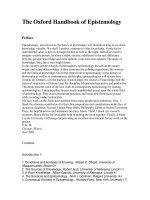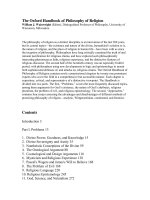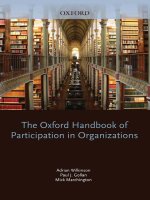The oxford handbook of music psychology (2016) susan hallam, ian cross
Bạn đang xem bản rút gọn của tài liệu. Xem và tải ngay bản đầy đủ của tài liệu tại đây (18.56 MB, 975 trang )
T h e Ox f o r d H a n d b o o k o f
M U SIC
P SYC HOL O G Y
the Oxford Handbook of
MUSIC
PSYCHOLOGY
Second Edition
Edited by
SU S A N HA L L A M , IA N C R O S S ,
and
M IC HA E L T HAU T
1
3
Great Clarendon Street, Oxford, OX2 6DP,
United Kingdom
Oxford University Press is a department of the University of Oxford.
It furthers the University’s objective of excellence in research, scholarship,
and education by publishing worldwide. Oxford is a registered trade mark of
Oxford University Press in the UK and in certain other countries
© Oxford University Press 2016
The moral rights of the authorshave been asserted
First Edition published in 2009
Second Edition published in 2016
Impression: 1
All rights reserved. No part of this publication may be reproduced, stored in
a retrieval system, or transmitted, in any form or by any means, without the
prior permission in writing of Oxford University Press, or as expressly permitted
by law, by licence or under terms agreed with the appropriate reprographics
rights organization. Enquiries concerning reproduction outside the scope of the
above should be sent to the Rights Department, Oxford University Press, at the
address above
You must not circulate this work in any other form
and you must impose this same condition on any acquirer
Published in the United States of America by Oxford University Press
198 Madison Avenue, New York, NY 10016, United States of America
British Library Cataloguing in Publication Data
Data available
Library of Congress Control Number: 2015957148
ISBN 978–0–19–872294–6
Printed and bound by
CPI Group (UK) Ltd, Croydon, CR0 4YY
Oxford University Press makes no representation, express or implied, that the
drug dosages in this book are correct. Readers must therefore always check
the product information and clinical procedures with the most up-to-date
published product information and data sheets provided by the manufacturers
and the most recent codes of conduct and safety regulations. The authors and
the publishers do not accept responsibility or legal liability for any errors in the
text or for the misuse or misapplication of material in this work. Except where
otherwise stated, drug dosages and recommendations are for the non-pregnant
adult who is not breast-feeding
Links to third party websites are provided by Oxford in good faith and
for information only. Oxford disclaims any responsibility for the materials
contained in any third party website referenced in this work.
Contents
List of Contributors
xi
PA RT 1 T H E OR IG I N S A N D
F U N C T ION S OF M U SIC
Edited by Ian Cross
1. The nature of music and its evolution
Ian Cross
2. Universals in music processing: Entrainment, acquiring
expectations, and learning
Catherine J. Stevens and Tim Byron
3. Music and meaning
Ian Cross and Elizabeth Tolbert
4. The social and personal functions of music
in cross-cultural perspective
Martin Clayton
3
19
33
47
PA RT 2 M U SIC P E RC E P T ION
Edited by Ian Cross
5. The perception of pitch
Thomas Stainsby and Ian Cross
63
6. Absolute pitch
Psyche Loui
81
7. Tonal cognition
Emmanuel Bigand and Bénédicte Poulin-Charronnat
95
8. The perception of musical timbre
Stephen McAdams and Bruno L. Giordano
113
vi Contents
9. Musical time
Mari Riess Jones
125
10. Tonality and contour in melodic processing
Mark A. Schmuckler
143
11. Memory for music
Bob Snyder
167
PA RT 3 R E SP ON SE S TO M U SIC
Edited by Donald A. Hodges
12. Bodily responses to music
Donald A. Hodges
183
13. Emotional reactions to music
Patrik N. Juslin
197
14. The relationship between musical structure
and perceived expression
Alf Gabrielsson
215
15. Aesthetics
David Huron
233
16. The neuroaesthetics of music
Donald A. Hodges
247
17. Musical preferences
Alinka Greasley and Alexandra Lamont
263
PA RT 4 M U SIC A N D T H E B R A I N
Edited by Jessica A. Grahn
18. The neurobiology of musical expectations
from perception to emotion
Laurel J. Trainor and Robert J. Zatorre
285
19. Disorders of music cognition
Psyche Loui
307
20.Music and brain plasticity
Simone Dalla Bella
325
Contents vii
21. The relationship between music and language
Sebastian Jentschke
343
22.The neuroscience of rhythm
Daniel J. Cameron and Jessica A. Grahn
357
PA RT 5 M U SIC A L DE V E L OP M E N T
Edited by Alexandra Lamont
23. Prenatal development and the phylogeny and ontogeny
of musical behavior
Richard Parncutt
371
24. Infant musicality
Sandra E. Trehub
387
25. Musical development from the early years onwards
Alexandra Lamont
399
26.Music training and nonmusical abilities
E. Glenn Schellenberg
415
PA RT 6 L E A R N I N G M U SIC A L SK I L L S
Edited by Susan Hallam
27. Musical potential
Gary E. McPherson and Susan Hallam
433
28. Practicing
Harald Jørgensen and Susan Hallam
449
29.Individuality in the learning of musical skills
Helena Gaunt and Susan Hallam
463
30.Motivation to learn
Susan Hallam
479
31. The role of the family in supporting learning
Andrea Creech
493
32. The role of the institution and teachers in supporting learning
Graham Welch and Adam Ockelford
509
viii Contents
PA RT 7 M U SIC A L P E R F OR M A N C E
Edited by Richard Parncutt
33. Planning and performance
Eckart Altenmüller and Shinichi Furuya
529
34. Sight-reading
Andreas C. Lehmann and Reinhardt Kopiez
547
35. Performing from memory
Roger Chaffin, Alexander P. Demos, and Topher Logan
559
36.Bodily mediated coordination, collaboration,
and communication in music performance
Jane W. Davidson and Mary C. Broughton
37. Emotion in music performance
Patrik N. Juslin and Erik Lindström
573
597
38.Expression and communication of structure in music
performance: Measurements and models
Erica Bisesi and W. Luke Windsor
615
39.Optimizing physical and psychological health
in performing musicians
Dianna T. Kenny and Bronwen J. Ackermann
633
PA RT 8 C OM P O SI T ION A N D I M P ROV I S AT ION
Edited by Peter R. Webster
40.Making a mark: The psychology of composition
Jonathan Impett
651
41. Musical improvisation
Richard Ashley
667
42.Pathways to the study of music composition by preschool
to precollege students
Peter R. Webster
681
Contents ix
PA RT 9 T H E ROL E OF M U SIC I N OU R
E V E RY DAY L I V E S
Edited by Raymond MacDonald
43.Choosing to hear music: Motivation, process, and effect
Alexandra Lamont, Alinka Greasley, and John Sloboda
711
44.Music in performance arts: Film, theater, and dance
Annabel J. Cohen
725
45.Peak experiences in music
Alf Gabrielsson, John Whaley, and John Sloboda
745
46. Musical identities
David J. Hargreaves, Raymond MacDonald,
and Dorothy Miell
759
47. The effects of music in community and educational settings
Susan Hallam and Raymond MacDonald
775
48.Music and consumer behavior
Adrian C. North, David J. Hargreaves,
and Amanda E. Krause
789
PA RT 10 M U SIC T H E R A P Y
Edited by Michael Thaut
49.Processes of music therapy: Clinical and scientific
rationales and models
Shannon K. de l’etoile
805
50.Clinical practice in music therapy
Corene Hurt-Thaut
819
51. Research in music therapy
Barbara L. Wheeler
837
52. Music therapy in medical and neurological rehabilitation settings
Stefan Mainka, Ralph Spintge, and Michael Thaut
857
x Contents
PA RT 11 C ON C E P T UA L F R A M E WOR K S ,
R E SE A RC H M E T HOD S , A N D F U T U R E
DI R E C T ION S
Edited by Susan Hallam, Ian Cross, and Michael Thaut
53. Beyond music psychology
Adam Ockelford
877
54.History and research
Michael Thaut
893
55. Where now?
Susan Hallam, Ian Cross, and Michael Thaut
905
Index
915
List of Contributors
Dr Bronwen J. Ackermann
Biomedical Sciences
School of Medical Sciences
Sydney Medical School
University of Sydney
Sydney, NSW 2006
Australia
Professor Eckart Altenmüller
Institut fur Musikphysiologie und
Musiker-Medizin
Hohenzollernstr 47
30161 Hannover
Germany
Dr Richard Ashley
Bienen School of Music
Northwestern University
70 Arts Circle Drive
Evanston, IL 60208
USA
Professor Emmanuel Bigand
LEAD CNRS UMR 5022
Université de Bourgogne
Pole AAFE
Esplanade Erasme, BP 26513
21065 Dijon Cedex
France
Dr Erica Bisesi
Centre for Systematic Musicology
University of Graz
Merangasse 70
A - 8010 Graz Austria
Dr Mary C. Broughton
School of Music
University of Queensland
Brisbane, QLD 4072
Australia
Dr Tim Byron
School of Psychology
McElwain Building
The University of Queensland
St Lucia, QLD 4072
Australia
Daniel J. Cameron
Brain and Mind Institute
University of Western Ontario
London, ON N6A 5B7
Canada
Professor Roger Chaffin
Department of Psychology
U-1020, University of Connecticut
406 Babbidge Road
Storrs, CT 06269-1020
USA
Professor Martin Clayton
Department of Music
Durham University
Durham, DH1 3RL
UK
Professor Annabel J. Cohen
Department of Psychology
University of Prince Edward Island
550 University Avenue
Charlottetown, PE C1A 4P3
Canada
Dr Andrea Creech
Department of Education
Practice and Society
University College London
Institute of Education
20 Bedford Way
London, WC1H OAL
UK
xii List of Contributors
Professor Ian Cross
Centre for Music & Science
Faculty of Music
University of Cambridge
11 West Road
Cambridge, CB3 9DP
UK
Professor Simone Dalla Bella
Euromov
University of Montpellier
34090 Montpellier
France
Professor Jane W. Davidson
Professor of Creative and
Performing Arts and
Deputy Director of ARC Centre of
Excellence for the History of Emotions
The University of Melbourne
Australia
Dr Shannon K. de l’Etoile
University of Miami
Frost School of Music
P O Box 248165
Coral Gables, FL 33124
USA
Dr Alexander P. Demos
McGill University 1205 Dr. Penfield Avenue
Montreal, QC H3A 1B1
Canada
Dr Shinichi Furuya
Department of Information and
Communication Sciences
Sophia University
Tokyo, 1028554
Japan
Professor Alf Gabrielsson
Department of Psychology
Uppsala University
Box 1225
SE – 751 42 Uppsala
Sweden
Professor Helena Gaunt
Guildhall School of Music & Drama
Silk Street
Barbican
London, EC2Y 8DT
UK
Dr Bruno L. Giordano
Institute of Neuroscience and Psychology
58 Hillhead Street
University of Glasgow
Glasgow, G12 8QB
Scotland
Dr Jessica A. Grahn
Brain and Mind Institute & Department of
Psychology
University of Western Ontario
London, ON N6A 5C2
Canada
Dr Alinka Greasley
School of Music
University of Leeds
Leeds, LS2 9JT
UK
Professor Susan Hallam
Department of Lifelong and Comparative
Education
University College London
Institute of Education
20 Bedford Way
London, WC1H OAL
UK
Professor David J. Hargreaves
Applied Music Research Centre
Roehampton University
Southlands College
Roehampton Lane
London, SW15 5SL
UK
Professor Donald A. Hodges
Music Research Institute
School of Music, Theater and Dance
University of North Carolina at Greensboro
P O Box 26170
Greensboro, NC 27402-6170
USA
List of Contributors xiii
Professor David Huron
School of Music
1866 College Road
Ohio State University
Columbus, OH 43210
USA
Professor Dianna T. Kenny
Faculty of Arts and Social Sciences
University of Sydney
Sydney, NSW 2006
Australia
Dr Corene Hurt-Thaut
MT-BC, Program Director
Unkefer Academy of Neurologic Music
Therapy
Professor Reinhardt Kopiez
Hochschule fur Musik, Theater und Medien
Emmichplatz 1,
D – 30175 Hannover
Germany
Colorado State University
Department of Music, Theatre, and Dance
1778 Campus Delivery
Fort Collins, CO 80523-1778
USA
Dr Amanda E. Krause
School of Psychology and Speech Pathology
Curtin University
Perth, WA 6102
Australia
Dr Jonathan Impett
School of Media and Performing Arts
Middlesex University
London, NW4 4BT
UK
Dr Alexandra Lamont
School of Psychology
Keele University
Keele, ST5 5BG
UK
Dr Sebastian Jentschke
Cluster “Languages of Emotion”
Freie Universität Berlin
Habelschwerdter Allee
45D-14195 Berlin
Germany
Professor Andreas C. Lehmann
Hochschule für Musik
Hofstallstrasse 6-8
D – 97070 Würzburg
Germany
Professor Mari Riess Jones
Department of Psychology
Ohio State University and University of
Santa Barbara California
5388 Traci Drive
Santa Barbara, CA 93111
USA
Professor Harald Jørgensen
The Norwegian Academy of Music
PB 5190 Majorstua
N-0302 Oslo
Norway
Professor Patrik N. Juslin
Department of Psychology
Uppsala University
Box 1225
SE – 751 42 Uppsala
Sweden
Dr Erik Lindström
Linnaeus University
Department of Psychology
391 82 Kalmar
Sweden
Dr Topher Logan
Community School of the Arts
University of Connecticut
U – 5195, 3 Witryol Place
Storrs, CT 06269-5195
USA
Dr Psyche Loui
Department of Psychology
Wesleyan University
Middletown, CT 06459
USA
xiv List of Contributors
Professor Raymond MacDonald
School of Music
University of Edinburgh
Edinburgh, EH8 9DF
UK
Stefan Mainka
Neurologisches Fachkrankenhaus
f. Bewegungsstrg./Parkinson
Beelitz-Heilstätten
Germany
Professor Stephen McAdams
Schulich School of Music
McGill University
Montreal, QC H3A 1E3
Canada
Professor Gary E. McPherson
University of Melbourne
Melbourne Conservatorium of Music
Royal Parade
Parkville VIC 3052
Australia
Professor Dorothy Miell
College of Humanities and Social Science
University of Edinburgh
Edinburgh, EH8 9JU
UK
Professor Adrian C. North
School of Psychology and Speech Pathology
Curtin University
Perth, WA 6102
Australia
Professor Adam Ockelford
School of Education
Roehampton University
Roehampton Lane
London, SW15 5PU
UK
Professor Richard Parncutt
Centre for Systematic Musicology
University of Graz
Merangasse 70
A - 8010 Graz
Austria
Dr Bénédicte Poulin-Charronnat
LEAD - CNRS UMR5022
Université de Bourgogne
Pôle AAFE
11 Esplanade Erasme
BP 26513 21065 Dijon Cedex
France
Professor E. Glenn Schellenberg
Department of Psychology
University of Toronto Mississauga
3359 Mississauga Road
Mississauga, ON L5L 1C6
Canada
Professor Mark A. Schmuckler
Department of Psychology
University of Toronto Scarborough
1265 Military Trail
Scarborough
ON, MIC 1A4
Canada
Professor John Sloboda
Guildhall School of Music & Drama
Silk Street
Barbican
London, EC2Y 8DT
UK
Professor Bob Snyder
Sound Department
School of the Art
Institute of Chicago
112 South Michigan Ave
Chicago, IL 60603
USA
Professor Ralph Spintge
Institute for Music Therapy
University for Music & Drama
Harvestehuder Weg 12
20148 Hamburg
Germany
Director
Department of Algesiology
Sportklinik Hellersen
58515 Luedenscheid
Germany
List of Contributors xv
Dr Thomas Stainsby
Department of Experimental
Psychology
University of Cambridge
Downing Street
Cambridge, CB2 3EB
UK
Professor Peter R. Webster
Department of Music Teaching and
Learning
Thornton School of Music
University of Southern California
Los Angeles, CA 90089-0851
USA
Professor Catherine J. Stevens
MARCS Auditory Laboratories
University of Western Sydney
Locked Bag 1797
Penrith South DC, NSW 1797
Australia
Professor Graham Welch
Department of Culture
Communication and Media
UCL Institute of Education
20 Bedford Way
London, WC1H OAL
UK
Professor Michael Thaut
Center for Biomedical Research
in Music
Colorado State University
Fort Collins, CO 80523
USA
Elizabeth Tolbert
The Peabody Institute
The Johns Hopkins University
1 East Mount Vernon Place
Baltimore, MD 21202
USA
Dr Laurel J. Trainor
Department of Psychology
Neuroscience & Behaviour
McMaster Institute for Music and the Mind
McMaster University
1280 Main Street W
Hamilton, ON L8S 4K1
Canada
Professor Sandra E. Trehub
Department of Psychology
University of Toronto at Mississauga
3359 Mississauga Road
Mississauga, L5L 1C6
Canada
John Whaley
7551 N. Chatham Ave
Portland, OR 97217
USA
Professor Barbara L. Wheeler
Montclair State University
Upper Montclair, NJ 07043
USA
Dr W. Luke Windsor
School of Music
University of Leeds
Leeds, LS2 9JT
UK
Professor Robert J. Zatorre
Montreal Neurological Institute
McGill University; and International
Laboratory for Brain, Music, and Sound
Research (BRAMS)
3801 University Street
Montreal, QC H3A 2B4
Canada
(a)
Major
Chords
Tones
(linked to right edge)
Keys
Minor
Chords
F#/Gb C#/Db G#/Ab D#/Eb A#/Bb
F
C
G
D
A
E
B
F#/Gb C#/Db G#/Ab D#/Eb A#/Bb
F
C
G
D
A
E
B
G
G#/Ab
A
A#/Bb
B
C
C#/Db
D
D#/Eb
E
F
F#/Gb
d#/eb
a#/bb
f
c
g
d
a
e
b
f#/gb c#/db
(linked to left edge)
(linked to lower edge-minor chords)
g#/ab
(linked to upper edge-keys)
Bottom-Up Activation
(b)
Keys
Tones
Minor
Chords
(linked to right edge)
Major
Chords
C#/Db G#/Ab D#/Eb A#/Bb
F
C
G
D
A
E
B
F#/Gb C#/Db G#/Ab D#/Eb A#/Bb
F
C
G
D
A
E
B
F#/Gb
A
A#/Bb
B
C
C#/Db
D
D#/Eb
E
F
F#/Gb
G
G#/Ab
d#/eb
a#/bb
f
c
g
d
a
e
b
f#/gb
c#/db
g#/ab
(linked to left edge)
(linked to lower edge-minor chords)
(linked to upper edge-keys)
Bottom-Up Activation
Top-Down Activation
Major
Chords
Tones
Minor
Chords
(linked to right edge)
Keys
F#/Gb
C#/Db G#/Ab D#/Eb A#/Bb
F
C
G
D
A
E
B
F#/Gb
C#/Db G#/Ab D#/Eb A#/Bb
F
C
G
D
A
E
B
A
A#/Bb
B
C
C#/Db
D
D#/Eb
E
F
F#/Gb
G
G#/Ab
d#/eb
a#/bb
f
c
g
d
a
e
b
f#/gb
c#/db
g#/ab
(linked to left edge)
(linked to lower edge-minor chords)
(c)
(linked to upper edge-keys)
Bottom-Up Activation
Top-Down Activation
Major
Chords
Tones
Minor
Chords
(linked to right edge)
Keys
F#/Gb
C#/Db G#/Ab D#/Eb A#/Bb
F
C
G
D
A
E
B
F#/Gb
C#/Db G#/Ab D#/Eb A#/Bb
F
C
G
D
A
E
B
A
A#/Bb
B
C
C#/Db
D
D#/Eb
E
F
F#/Gb
G
G#/Ab
d#/eb
a#/bb
f
c
g
d
a
e
b
f#/gb
c#/db
g#/ab
(linked to left edge)
(linked to lower edge-minor chords)
(d)
(linked to upper edge-keys)
Figure 7.3 Bharucha’s MUSACT model (a) When three tones are sounding, activation
spread from tones to chord units (b), and then from chord to key and tone units (c), and
from key units to chord and from tone to chord units (d) and so on up to equilibrium.
30
∗
∗
∗
∗
other emotion
10
anger−irritation
20
boredom−indifference
Frequency (%)
40
∗
∗
disgust−contempt
shame−guilt
surprise−amazement
love−tenderness
nostalgia−longing
sadness−melancholy
anxiety−fear
pleasure−enjoyment
interest−expectancy
happiness−elation
calm−contentment
0
Emotion
Figure 13.1 Relative frequency (in percent) of felt emotions for nonmusical emotion episodes (dark bars) and musical emotion episodes (light bars) during a two-week
period as indexed by experience sampling in everyday life.
(*p < .05)
(Reproduced from Patrik N. Juslin, Simon Liljeström, Daniel Västfjäll, Gonçalo Barradas, Ana Silva, An experience
sampling study of emotional reactions to music: Listener, music, and situation, Emotion, 8(5), pp. 668–683,
DOI: 10.1037/a0013505 © 2008, American Psychological Association.)
Figure 18.4 Induced oscillatory neuromagnetic responses to isochronous beat sequences.
(a) Time-frequency plots of induced oscillatory activity in right auditory cortex between
10 and 40 Hz in response to a fast (390 ms onset-to-onset; upper plot), moderate (585
ms; middle plot) and slow (780 ms; lower plot) tempo (n = 12). In each case, activity in
the beta band decreases after stimulus onset, and rebounds with timing predictive of the
onset of the next beat. (b) The time at which the beta desynchronization reaches half
power (squares) and minimum power (triangles), and the time at which the rebound
(resynchronization) reaches half power (circles). The timing of the desynchronization is
similar across the three stimulus tempos, but the time of the rebound resynchronization
depends on the stimulus tempo in a predictive manner. (c) Areas across the brain in
which beta activity was modulated by the auditory stimulus, showing involvement of
both auditory cortices and a number of motor regions.
(Data from Takako Fujioka, Laurel J. Trainor, Edward W. Large, and Bernhard Ross, Internalized timing of
isochronous sounds is represented in neuromagnetic beta oscillations.
Journal of Neuroscience, 32(5), 1791–1802, 2012.)
PET: Dopamine response
fMRI: Anticipation
Caudate
Caudate
Experience
Nucleus Accumbens
Nucleus Accumbens
Error bars show mean ± 1.0 SE
1 Mean
Neutral
Anticipation
Exp.
0
–1
–5
–4
–3
–2
–1
A1
A2
A3
A4
A5
A6
A7
A8
A9
A10
A11
A12
A13
A14
A15
C1
C2
C3
C4
Voxel of Interest
Right Caudate
Right NAcc
% Signal Change
Chill
Timeseries
Figure 18.5 Top left: Positron emission tomography scan (coronal section through the
striatum) showing evidence for dopamine release during highly pleasurable music in
both nucleus accumbens and caudate. Top right: functional MRI scans from the same
participants scanned with PET showing dissociation between brain activity in the caudate nucleus during the anticipatory phase (prior to the peak pleasure, as indexed by
the “chill” response), and in the nucleus accumbens during the experiential phase, during the peak pleasure. Bottom: averaged traces demonstrating the temporal course of
activity in the two regions shown above.
(Adapted by permission from Valorie N. Salimpoor, Mitchel Benovoy, Kevin Larcher, Alain Dagher, and Robert
J Zatorre, Anatomically distinct dopamine release during anticipation and experience of peak emotion to music,
Nature Neuroscience, 14(2), 257–262, figure 1, doi:10.1038/nn.2726 © 2011, Macmillan Publishers Limited.)
(a)
(b)
Cortical thickness Residuals (mm)
t-statistics
3.75
Right IFG
2.3
Right STG
0.4
0.2
0.0
−0.2
−0.4
−0.6
−0.8
Amusics
Controls
16 18 20 22 24 26 28 30
Global Musical Score
Cortical thickness Residuals (mm)
(c)
0.4
0.2
0.0
−0.2
−0.4
−0.6
Amusics
Controls
−0.8
16
18
20 22 24 26 28
Global Musical Score
30
Figure 19.1 Cortical thickness measures showed right hemisphere differences among
amusics (a), with effects centering around the inferior frontal gyrus (b) and the superior
temporal gyrus (c).
(Reproduced from Krista L. Hyde, Jason P. Lerch, Robert J. Zatorre, Timothy D. Griffiths, Alan C. Evans, and
Isabelle Peretz, Cortical thickness in congenital amusia: when less is better than more, The Journal of
Neuroscience, 27(47), 13028–13032, figure 2 © 2007, The Society for Neuroscience, with permission.)
(a)
(b)
Figure 19.2 DTI images showing the arcuate fasciculus in a control subject (a) and a
tone-deaf individual (b). Results showed less volume and structural connectivity in the
arcuate fasciculus among tone-deaf individuals.
(Reproduced from Psyche Loui, David Alsop, and Gottfried Schlaug, Tone Deafness: A New Disconnection
Syndrome?, The Journal of Neuroscience, 29 (33), pp, 10215–10220, figure 2 © 2009, The Society
for Neuroscience, with permission.)
L
A
R
P
P
x = −50 ± 2 mm
A
x = 42 ± 2 mm
z = 6 ± 2 mm
Amusics versus Controls
(a) Current study
MEG ERFs
MEG Oscillations
VBM White Matter
VBM Grey Matter
(b) Passive listening
Hyde et al., 2011
Typical individuals
(c) DTI study
pSTG (Loui et al. 2009)
(d) fMRI/PET
Passive listening
Attentive listening
pIFG (Loui et al. 2009)
Short Term Memory (STM)
Janata et al., 2002a
Zatorre et al., 1994
Griffiths et al., 1999
Perception + STM
Figure 19.3 MEG and VBM data converged with the right fronto-temporal account
of amusia.
(This material was originally published in Philippe Albouy, Jérémie Mattout, Romain Bouet, Emmanuel Maby,
Gaëtan Sanchez, Pierre-Emmanuel Aguera, Sébastien Daligault, Claude Delpuech, Olivier Bertrand,
Anne Caclin, and Barbara Tillmann, Impaired pitch perception and memory in congenital amusia: the
deficit starts in the auditory cortex, Brain, 136 (5), pp. 1639–1661, Figure 12, doi: 10.1093/brain/awt082
2013, Oxford University Press and has been reproduced by permission of Oxford University Press
[ For permission to reuse this material, please visit
/>
0.60
Mean
0.40
0.20
Behavioural support
Cognitive/Intellectual
support
0.00
Personal support
–0.20
–0.40
H
m
ar
us
io
o
tri
o
tri
uo
o
du
uo
td
nt
da
on
or
ic
ed
bl
isc
D
ou
D
am
yn
D
an
in
r
de
lea
om
D
lo
So
Cluster
Figure 31.2 Parent support according to parent–teacher–pupil interaction type (standardized scores).
Mean score for relevance of musical activities
0.40
0.20
Extra-curricular
Acquiring practical
skills
Music for fun
Solo work
0.00
–0.20
–0.40
Non-classical
Classical
Musical genre
Figure 32.5 Classical and other-than-classical-musicians’ mean scores for categories
of musical activities (extra-curricular: listening to music from own and outside of own
genre, acquiring general musical knowledge, engaging in professional conversations,
networking; acquiring practical skills: practicing alone, practicing with others, taking
lessons, solo and group performance, listening to music from own genre; music for
fun: playing for fun alone or with other; solo work: mental rehearsal, giving lessons,
solo performance).
Reproduced from Investigating musical performance: commonality and diversity amongst classical and other-thanclassical musicians, Andrea Creech, Ioulia Papageorgi, Celia Duffy, Frances Morton, Elizabeth Hadden, John Potter,
Christophe De Bezenac, Tony Whyton, Evangelos Himonides & Graham Welch, Music Education Research, 10(2), p.
223 DOI: 10.1080/14613800802079080 © 2008, Taylor & Francis Ltd, .)









